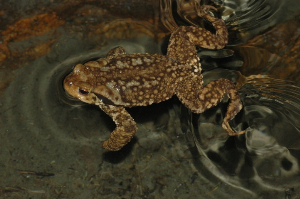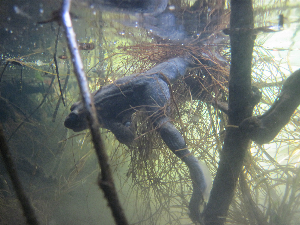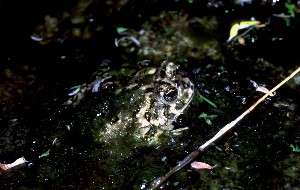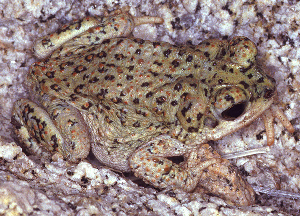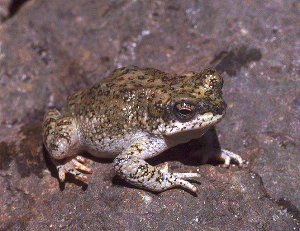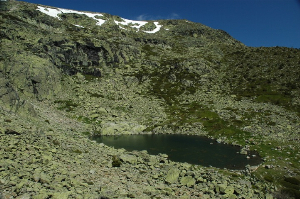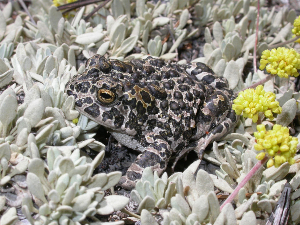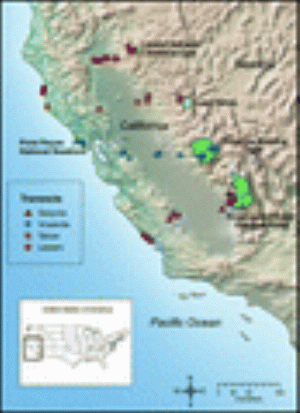Search ARMI Database
Search term(s)
Contribution Number
Search Results
876 record(s) found.
Papers & Reports Assessing the terrestrial movement patterns and habitat preferences of the common toad (Bufo bufo) in a montane area of Central Spain
Authors: D av D; Erin Muths; B os J
Date: 2012 | Outlet: Journal of Herpetology
Widespread amphibian declines and habitat fragmentation, coupled with advancements in tracking technology, have sparked increased emphasis on studying movements and the use of terrestrial habitats by amphibians. Peñalara Natural Park, Sierra de Guadarrama, Central Spain, provides habitat for a number of amphibians that use upland sites. In response to increased pressure on habitat in this region by tourism, we used 4 months of radio telemetry data for 17 adult Common Toads (Bufo bufo) to characterize the terrestrial movements, assess the factors influencing these movements, and determine the distribution and cover characteristics of summer refugia for these toads. We found that: a) movements were most pronounced following the breeding season in June and adults made movements of up to 470 m away from breeding sites, b) movements were not influenced by basin size, climatic variables or the sex the individual, c) the amount of terrestrial habitat used by toads ranged from 245 m2 to 2.5 ha, and d) within these areas toads most often used rock piles and juniper patches (Juniper communis nana) as cover during the summer. Our study emphasizes the importance of considering terrestrial landscapes when developing conservation strategies, and we suggest that a buffer of minimal development extending 550 m from the shoreline of each natal pond be considered when conservation plans are developed for Common Toad habitat in Peñalara.
Papers & Reports COMPARATIVE MICROHABITAT CHARACTERISTICS AT OVIPOSITON SITES OF THE CALIFORNIA RED-LEGGED FROG (RANA DRAYTONII)
Authors: Jeff A Alvarez; D G Cook; J L Yee; Michael G van Hattem; D R Fong; Robert N Fisher
Date: 2013-12-31 | Outlet: Herpetological Conservation and Biology
We studied the microhabitat characteristics of 747 egg masses of the federallythreatened California Red-legged Frog (Rana draytonii) at eight sites in California. Our study showed that a broad range of aquatic habitats are utilized by ovipositing R. draytonii, including sites with perennial and ephemeral water sources, natural and constructed wetlands, lentic and lotic hydrology, and sites surrounded by protected lands and nested within modified urban areas. We recorded 45 different egg mass attachment types, although the use of only a few types was common at each site. These attachment types ranged from branches and roots of riparian trees, emergent and submergent wetland vegetation, flooded upland grassland/ruderal vegetation, and debris. Eggs were deposited in relatively shallow water (mean 39.7 cm) when compared to maximum site depths. We found that most frogs in artificial pond, natural creek, and artificial channel habitats deposited egg masses within one meter of the shore, while egg masses in a seasonal marsh averaged 27.3 m from the shore due to extensive emergent vegetation. Rana draytonii appeared to delay breeding in lotic habitats and in more inland sites compared to lentic habitats and coastal sites. Eggs occurred as early as mid-December at a coastal artificial pond and as late as mid-April in an inland natural creek. We speculate that this delay in breeding may represent a method of avoiding high-flow events and/or freezing temperatures. Understanding the factors related to the reproductive needs of this species can contribute to creating, managing, or preserving appropriate habitat, and promoting species recovery.
Papers & Reports Co-Occurrence of Invasive Cuban Treefrogs and Native Treefrogs in PVC Pipe Refugia
Authors: L M Elston; Hardin J Waddle; Kenneth G Rice; H F Percival
Date: 2013 | Outlet: Herpetological Review 44:406-409
Papers & Reports RANA DRAYTONII (California Red-legged Frog). UNUSUAL DEATH
Authors: Adam R Backlin; Katherine L Baumberger
Date: 2013 | Outlet: Herpetological Review
While conducting monitoring surveys on February 26, 2013 at the southernmost extant population in the USA, an adult male [Rana draytonii] was discovered dead, entangled in several native blackberry ([Rubus ursinus]) vines just below the surface of the water.
Papers & Reports Correction of Locality Records for the Endangered Arroyo Toad (Anaxyrus californicus) from the Desert Region of Southern California
Authors: Edward L Ervin; Kent R Beaman; Robert N Fisher
Date: 2013-12 | Outlet: Bulletin of the Southern California Academy of Sciences
The development of an effective recovery plan for an endangered species requires knowledge of that species distribution and spatial arrangements within preferred habitat. Although the best available information of a species distribution is used to develop a plan, it is often lacking in regard to its actual geographical extent. The arroyo toad (Anaxyrus californicus) occurs in coastal drainages from Monterey County, California, south into northwestern Baja California, Mexico. Through field reconnaissance and the study of museum specimens, we determined that the four reported populations of the arroyo toad in the Sonoran Desert region of Riverside, San Diego, and Imperial counties, California are in error. Two additional sites in the Sonoran Desert are discussed regarding the possibility that the species occurs there. We recommend the continued study of arroyo toad populations in order to establish a better understanding of their distribution and the boundaries of their geographical range.
Papers & Reports Evolutionary Hotspots in the Mojave Desert
Authors: A G Vandergast; R D Inman; Kelly R Barr; K E Nussear; T C Esque; Stacie A Hathaway; D A Wood; P A Medica; Jesse W Breinholt; C L Stephen; A D Gottscho; S B Marks; W B Jennings; Robert N Fisher
Date: 2013-04-15 | Outlet: Diversity 5:293-319
Genetic diversity within species provides the raw material for adaptation and evolution. Just as regions of high species diversity are conservation targets, identifying regions containing high genetic diversity and divergence within and among populations may be important to protect future evolutionary potential. When multiple co-distributed species show spatial overlap in high genetic diversity and divergence, these regions can be considered evolutionary hotspots. We mapped spatial population genetic structure for 17 animal species across the Mojave Desert, USA. We analyzed these in concurrence and located 10 regions of high genetic diversity, divergence or both among species. These were mainly concentrated along the western and southern boundaries where ecotones between mountain, grassland and desert habitat are prevalent, and along the Colorado River. We evaluated the extent to which these hotspots overlapped protected lands and utility-scale renewable energy development projects of the Bureau of Land Management. While 30–40% of the total hotspot area was categorized as protected, between 3–7% overlapped with proposed renewable energy project footprints, and up to 17% overlapped with project footprints combined with transmission corridors. Overlap of evolutionary hotspots with renewable energy development mainly occurred in 6 of the 10 identified hotspots. Resulting GIS-based maps can be incorporated into ongoing landscape planning efforts and highlight specific regions where further investigation of impacts to population persistence and genetic connectivity may be warranted.
Papers & Reports Comparative phylogeography reveals deep lineages and regional evolutionary hotspots in the Mojave and Sonoran Deserts
Authors: D A Wood; A G Vandergast; Kelly R Barr; R D Inman; T C Esque; K E Nussear; Robert N Fisher
Date: 2012 | Outlet: Diversity and Distributions 19:722-737
Aim We explored lineage diversification within desert-dwelling fauna. Our goals were (1) to determine whether phylogenetic lineages and population expansions were consistent with younger Pleistocene climate fluctuation hypotheses or much older events predicted by pre-Pleistocene vicariance hypotheses, (2) to assess concordance in spatial patterns of genetic divergence and diversity among species and (3) to identify regional evolutionary hotspots of divergence and diversity and assess their conservation status.
Location Mojave, Colorado, and Sonoran Deserts, USA.
Methods We analysed previously published gene sequence data for twelve species. We used Bayesian gene tree methods to estimate lineages and divergence times. Within each lineage, we tested for population expansion and age of expansion using coalescent approaches. We mapped interpopulation genetic divergence and intra-population genetic diversity in a GIS to identify hotspots of highest genetic divergence and diversity and to assess whether protected lands overlapped with evolutionary hotspots.
Results In seven of the 12 species, lineage divergence substantially predated the Pleistocene. Historical population expansion was found in eight species, but expansion events postdated the Last Glacial Maximum (LGM) in only four. For all species assessed, six hotspots of high genetic divergence and diversity were concentrated in the Colorado Desert, along the Colorado River and in the Mojave/Sonoran ecotone. At least some proportion of the land within each recovered hotspot was categorized as protected, yet four of the six also overlapped with major areas of human development.
Main conclusions Most of the species studied here diversified into distinct Mojave and Sonoran lineages prior to the LGM – supporting older diversification hypotheses. Several evolutionary hotspots were recovered but are not strategically paired with areas of protected land. Long-term preservation of species-level biodiversity would entail selecting areas for protection in Mojave and Sonoran Deserts to retain divergent genetic diversity and ensure connectedness across environmental gradients.
Location Mojave, Colorado, and Sonoran Deserts, USA.
Methods We analysed previously published gene sequence data for twelve species. We used Bayesian gene tree methods to estimate lineages and divergence times. Within each lineage, we tested for population expansion and age of expansion using coalescent approaches. We mapped interpopulation genetic divergence and intra-population genetic diversity in a GIS to identify hotspots of highest genetic divergence and diversity and to assess whether protected lands overlapped with evolutionary hotspots.
Results In seven of the 12 species, lineage divergence substantially predated the Pleistocene. Historical population expansion was found in eight species, but expansion events postdated the Last Glacial Maximum (LGM) in only four. For all species assessed, six hotspots of high genetic divergence and diversity were concentrated in the Colorado Desert, along the Colorado River and in the Mojave/Sonoran ecotone. At least some proportion of the land within each recovered hotspot was categorized as protected, yet four of the six also overlapped with major areas of human development.
Main conclusions Most of the species studied here diversified into distinct Mojave and Sonoran lineages prior to the LGM – supporting older diversification hypotheses. Several evolutionary hotspots were recovered but are not strategically paired with areas of protected land. Long-term preservation of species-level biodiversity would entail selecting areas for protection in Mojave and Sonoran Deserts to retain divergent genetic diversity and ensure connectedness across environmental gradients.
Papers & Reports Population-level thermal performance of a cold-water ectotherm is linked to ontogeny and local environmental heterogeneity
Authors: Blake R Hossack; W H Lowe; M AH Webb; M J Talbott; K M Kappenman; P. Stephen Corn
Date: 2013-11 | Outlet: Freshwater Biology 58:2215-2225
1. Negative effects of global warming are predicted to be most severe for species that occupy a narrow range of temperatures, have limited dispersal abilities, or have long generation times. These are characteristics typical of many species that occupy small, cold streams.
2. Habitat use, vulnerabilities and mechanisms for coping with local conditions can differ among populations and ontogentically within populations, potentially affecting species-level responses to climate change. However, we still have little knowledge of mean thermal performance for many vertebrates, let alone variation in performance among populations. Assessment of these sources of variation in thermal performance is critical for projecting the effects of climate change on species and for identifying management strategies to ameliorate its effects.
3. To gauge how populations of the Rocky Mountain tailed frog (Ascaphus montanus) might respond to long-term effects of climate change, we measured the ability of tadpoles from six populations in Glacier National Park (Montana, USA) to acclimate to a range of temperatures. We compared survival among populations according to tadpole age (age 1-yr or 2-yr) and according to the mean and variance of late-summer temperatures in natal streams.
4. The ability of tadpoles to acclimate to warm temperatures increased with age and with variance in late-summer temperature of natal streams. Moreover, performance differed among populations from the same catchment.
5. Our experiments with a cold-water species show that population-level performance varies across small geographic scales and is linked to local environmental heterogeneity. This variation could influence the rate and mode of species-level responses to climate change, both by facilitating local persistence in the face of changes in thermal conditions, and by providing thermally-tolerant colonists to neighbouring populations.
2. Habitat use, vulnerabilities and mechanisms for coping with local conditions can differ among populations and ontogentically within populations, potentially affecting species-level responses to climate change. However, we still have little knowledge of mean thermal performance for many vertebrates, let alone variation in performance among populations. Assessment of these sources of variation in thermal performance is critical for projecting the effects of climate change on species and for identifying management strategies to ameliorate its effects.
3. To gauge how populations of the Rocky Mountain tailed frog (Ascaphus montanus) might respond to long-term effects of climate change, we measured the ability of tadpoles from six populations in Glacier National Park (Montana, USA) to acclimate to a range of temperatures. We compared survival among populations according to tadpole age (age 1-yr or 2-yr) and according to the mean and variance of late-summer temperatures in natal streams.
4. The ability of tadpoles to acclimate to warm temperatures increased with age and with variance in late-summer temperature of natal streams. Moreover, performance differed among populations from the same catchment.
5. Our experiments with a cold-water species show that population-level performance varies across small geographic scales and is linked to local environmental heterogeneity. This variation could influence the rate and mode of species-level responses to climate change, both by facilitating local persistence in the face of changes in thermal conditions, and by providing thermally-tolerant colonists to neighbouring populations.
Papers & Reports Monitoring and managing declines in an amphibian community
Authors: Evan HC Grant; E F Zipkin; J D Nichols; J P Campbell
Date: 2013 | Outlet: Conservatoin
Although many taxa have declined globally, conservation actions are inherently local. Ecosystems degrade even in protected areas, and maintaining natural systems in a desired condition may require active management. Implementing management decisions under uncertainty requires a logical and transparent process to identify objectives, develop management actions, formulate system models linking actions with objectives, monitor to reduce uncertainty and identify system state (i.e., xxx [define system state parenthetically]), and determine an optimal management strategy. We applied one such structured decision-making approach that incorporates these critical elements to inform management of amphibian populations in a protected area. Climate change is expected to affect amphibian occupancy of wetlands and to increase uncertainty in management decision making. We used the tools of structured decision making to identify short-term management solutions that incorporate our current understanding of the effect of climate change on amphibians, emphasizing how management can be undertaken even with incomplete information. .
Papers & Reports Effects of natural flooding and trapping on the facilitation of invasive crayfish-native amphibian coexistence in a semi-arid perennial stream.
Authors: Lee B Kats; Gary Bucciarelli; Thomas L Vandergon; R L Honeycutt; E Mattiasen; A Sanders; Seth PD Riley; Jacob L Kerby; Robert N Fisher
Date: 2013-09 | Outlet: Journal of Arid Environments 98:109-112
Aquatic amphibians are known to be vulnerable to a myriad of invasive predators. Invasive crayfish are thought to have eliminated native populations of amphibians in some streams in the semi-arid Santa Monica Mountains of southern California. Despite their toxic skin secretions that defend them from native predators, newts are vulnerable to crayfish attacks, and crayfish have been observed attacking adult newts, eating newt egg masses and larvae. For 15 years we have observed invasive crayfish and native California newts coexisting in one stream in the Santa Monica Mountains. During that period we monitored the densities of both crayfish and newt egg mass densities and compared these to annual rainfall totals. After three seasons of below average rainfall, we reduced crayfish numbers by manual trapping. Our long-term data suggest that crayfish do not fare well in years when rainfall is above the historic average. This invasive predator did not evolve with high velocity streams and observations suggest southern California storm events wash crayfish downstream, killing many of them. Newts exhibit increased reproduction in years when crayfish numbers are reduced. A comparison with a nearby stream that does not contain crayfish suggests that newt reproduction positively responds to increased rainfall, but that fluctuations are much greater in the stream that contains crayfish. We suggest that rainfall patterns help explain invasive crayfish/newt coexistence and that management for future coexistence may benefit from manual trapping.
Papers & Reports Experimental evidence for American bullfrog (Lithobates catesbeianus) susceptibility to chytrid fungus (Batrachochytrium dendrobatidis)
Authors: S S Gervasi; J Urbina; J Hua; T Chestnut; Rick A Relyea; Andrew R Blaustein
Date: 2013-03-29 | Outlet: EcoHealth DOI: 10.1007/s10393-013-0832-8
The emerging fungal pathogen, Batrachochytrium dendrobatidis (Bd), has been associated with global amphibian population declines and extinctions. American bullfrogs (Lithobates catesbeianus) are widely reported to be a tolerant host and a carrier of Bd that spreads the pathogen to less tolerant hosts. Here, we examined whether bullfrogs raised from eggs to metamorphosis in outdoor mesocosms were susceptible to Bd. We experimentally exposed metamorphic juveniles to Bd in the laboratory and compared mortality rates of pathogen-exposed animals to controls (non-exposed) in two separate experiments; one using a Bd strain isolated from a Western toad and another using a strain isolated from an American bullfrog. We wanted to examine whether metamorphic bullfrogs were susceptible to either of these strains. We show that bullfrogs were susceptible to one strain of Bd and not the other. In both experiments, infection load detected in the skin decreased over time, suggesting that metamorphic bullfrogs from some populations may be inefficient long- term carriers of Bd.
Papers & Reports Factors Influencing Detection of eDNA from a Stream-dwelling Amphibian
Authors: David S Pilliod; Caren S Goldberg; R S Arkle; L P Waits
Date: 2014 | Outlet: Molecular Ecology Resources 14:109-116
Environmental DNA (eDNA) methods for detecting and estimating abundance of aquatic species are emerging rapidly, but little is known about how processes such as secretion rate, environmental degradation, and time since colonization or extirpation from a given site affect eDNA measurements. Using stream-dwelling salamanders, we conducted three experiments to assess eDNA from qPCR analysis: (1) production rate, (2) persistence time under different temperature and light conditions, and (3) detectability and concentration through time following experimental introduction and removal of salamanders into previously unoccupied streams. We found that 44–50 g individuals held in aquaria produced 20.2 ng eDNA/L/hr for two hours, after which production either decreased considerably or equilibrated with degradation and settling rates. eDNA in both full-sun and shaded treatments degraded exponentially to <1% of the original concentration after 3 days. eDNA was no longer detectable in full-sun samples after 8 days, whereas eDNA was detected in 20% of shaded samples after 11 days and 100% of control samples after 18 days. When translocated into unoccupied streams, salamanders were detectable after 6 hours, but only when densities were relatively high (0.2481 individuals/m2) and when samples were collected within 5 m of the animals. Concentrations of eDNA detected were very low and increased steadily from 6–24 hours after introduction, reaching 0.0022 ng/L. Within 1 hour of removing salamanders from the stream, eDNA was no longer detectable. These results suggest that eDNA detectability and concentration depend on production rates of individuals, environmental conditions, density of animals, and their residence time.
Papers & Reports Estimating Occupancy and Abundance of Stream Amphibians Using Environmental DNA from Filtered Water Samples
Authors: David S Pilliod; Caren S Goldberg; R S Arkle; L P Waits
Date: 2013 | Outlet: Canadian Journal Fisheries and Aquatic Sciences 70:1123-1130
Environmental DNA (eDNA) methods for detecting aquatic species are advancing rapidly, but with little evaluation of field protocols or precision of resulting estimates. We compared sampling results from traditional field methods with eDNA methods for two amphibians in 13 streams in central Idaho, USA. We also evaluated three water collection protocols and the influence of sampling location, time of day, and distance from animals on eDNA concentration in the water. We found no difference in detection or amount of eDNA among water collection protocols. eDNA methods had slightly higher detection rates than traditional field methods, particularly when species occurred at low densities. eDNA concentration was positively related to field-measured density, biomass, and proportion of transects occupied. Precision of eDNA-based abundance estimates increased with the amount of eDNA in the water and the number of replicate sub-samples collected, but eDNA concentration did not vary significantly with sample location in the stream, time of day, or distance downstream from animals. Our results further advance the implementation of eDNA methods for monitoring aquatic vertebrates in stream habitats.
Papers & Reports Prevalence of the amphibian chytrid fungus (Bd) at Buenos Aires National Wildlife Refuge, Arizona
Authors: Brent H Sigafus; Cecil R Schwalbe; Blake R Hossack; Erin Muths
Outlet: Herpetological Review
Prevalence of the amphibian chytrid fungus on Buenos Aires National Wildlife Refuge is low. Very few bullfrogs (a carrier of Bd) on the refuge test positive and very few Chiricahua Leopard Frogs test positive (only at sites off of the refuge). Bullfrogs have been nearly eradicated from the refuge, but because they carry the disease, there is potential for bullfrogs to act as a vector, carrying the disease to the Chiricahua Leopard Frogs which are an endangered species if they move back onto the refuge.
Papers & Reports Evidence for Plasticity in the Frequency of Skipped Breeding Opportunities in Common Toads
Authors: Erin Muths; R D Scherer; Jaime Bosch
Date: 2013 | Outlet: Population Ecology
Breeding is limited by energetic or environmental constraints and long-lived species sometimes skip breeding opportunities. Environmental conditions may vary considerably across the geographic and elevational range of a species and species that can respond through variation in life history strategies are likely to maintain populations at the extremes of their ranges. The decision to skip breeding enables animals to adjust life history to circumstances, and plasticity in behavior allows implementation of adjustments. Elevational patterns suggest that breeding may be limited physiologically at high elevations (e.g., greater probability of skipped breeding; resources and environmental conditions more variable) in contrast to low elevations (probability of skipping breeding lower; resources and environmental conditions more predictable). We estimated the probabilities of survival and skipped breeding in a high-elevation population of Common Toads and compared estimates to existing data for Common Toads at low elevations, and to another toad species inhabiting a similar high elevation environment. Female Common Toads at high elevations tend to have high probabilities of skipping breeding and survival relative to data for Common Toads at low elevations, and appear to use a similar strategy of skipping breeding in response to similar environmental constraints as other toads at high elevations. We provide evidence of variability in this aspect of life history for Common Toads. Understanding variation in life history within widely distributed species is critical. Knowing that certain life history strategies are employed on a continuum informs conservation efforts, especially as impacts of climate change are likely to be different depending on elevation.
Papers & Reports Trends in amphibian occupancy in the United States
Authors: Michael J Adams; David AW Miller; Erin Muths; P. Stephen Corn; Evan HC Grant; Larissa L Bailey; Gary M Fellers; Robert N Fisher; Walt J Sadinski; Hardin J Waddle; Susan C Walls
Date: 2013-05-22 | Outlet: PLoS ONE 8(5):e64347
Though a third of amphibian species worldwide are thought to be imperiled, existing assessments simply categorize extinction risk, providing little information on the rate of population losses. We conducted the first analysis of the rate of change in the probability that amphibians occupy ponds and other comparable habitat features across the United States. We found that overall occupancy by amphibians declined 3.7% annually from 2002 to 2011. Species that are Red-listed by the International Union for Conservation of Nature (IUCN) declined an average of 11.6% annually. All subsets of data examined had a declining trend including species in the IUCN Least Concern category. This analysis suggests that amphibian declines may be more widespread and severe than previously realized.
Papers & Reports A network extension of species occupancy models in a patchy environment applied to the Yosemite toad (Anaxyrus canorus)
Authors: Eric L Berlow; Roland A Knapp; S M Ostoja; R J Williams; H McKenny; J R Matchett; Q Guo; Gary M Fellers; Patrick M Kleeman; Matthew L Brooks; L Joppa
Date: 2013-08 | Outlet: PLoS ONE 8(8): e72200.
A central challenge of conservation biology is using limited data to predict rare species occurrence and identify conservation areas that play a disproportionate role in regional persistence. Where species occupy discrete patches in a landscape, such predictions require data about environmental quality of individual patches and the connectivity among high quality patches. We present a novel extension to species occupancy modeling that blends traditional predictions of individual patch environmental quality with network analysis to estimate connectivity characteristics using limited survey data. We demonstrate this approach using environmental and geospatial attributes to predict observed occupancy patterns of the Yosemite toad (Anaxyrus (= Bufo) canorus) across >2,500 meadows in Yosemite National Park (USA). A. canorus, a Federal Candidate Species, breeds in shallow water associated with meadows. Our generalized linear model (GLM) model accurately predicted ~84% of true presence-absence data on a subset of data withheld for testing. The predicted environmental quality of each meadow was iteratively ‘boosted’ by the quality of neighbors within dispersal distance. We used this park-wide meadow connectivity network to estimate the relative influence of an individual meadow’s ‘environmental quality’ versus its ‘network quality’ to predict: a) clusters of high quality breeding meadows potentially linked by dispersal, b) breeding meadows with high environmental quality that are isolated from other such meadows, c) breeding meadows with lower environmental quality where long-term persistence may critically depend on the network neighborhood, and d) breeding meadows with the biggest impact on park-wide breeding patterns. Combined with targeted data on dispersal, genetics, disease, and other potential stressors, these results can guide designation of core conservation areas for A. canorus in Yosemite National Park.
Papers & Reports Accumulation of pesticides in Pacific chorus frogs Pseudacris regilla from California's Sierra Nevada mountains, USA
Authors: Kelly L Smalling; Gary M Fellers; Patrick M Kleeman; Kathryn M Kuivila
Date: 2013-07 | Outlet: Environmental Toxicology and Chemistry 32:2026-2034
Pesticides are receiving increasing attention as potential causes of amphibian declines, acting singly or in combination with other stressors, but limited information is available on the accumulation of current-use pesticides in tissue. The authors examined potential exposure and accumulation of currently used pesticides in pond-breeding frogs (Pseudacris regilla) collected from 7 high elevations sites in northern California. All sites sampled are located downwind of California’s highly agricultural Central Valley and receive inputs of pesticides through precipitation and/or dry deposition. Whole frog tissue, water, and sediment were analyzed for more than 90 current-use pesticides and pesticide degradates using gas chromatography–mass spectrometry. Two fungicides, pyraclostrobin and tebuconazole, and one herbicide, simazine, were the most frequently detected pesticides in tissue samples. Median pesticide concentration ranged from 13 mg/kg to 235 mg/kg wet weight. Tebuconazole and pyraclostrobin were the only 2 compounds observed frequently in frog tissue and sediment. Significant spatial differences in tissue concentration were observed, which corresponded to pesticide use in the upwind counties. Data generated indicated that amphibians residing in remote locations are exposed to and capable of accumulating current-use pesticides. A comparison of P. regilla tissue concentrations with water and sediment data indicated that the frogs are accumulating pesticides and are potentially a more reliable indicator of exposure to this group of pesticides than either water or sediment.
Papers & Reports Roles of habitat, restoration, and drought frequency in driving long-term trends of a widespread amphibian
Authors: Blake R Hossack; Michael J Adams; Christopher A Pearl; K W Wilson; Evelyn L Bull; K Lohr; Debra A Patla; David S Pilliod; J M Jones; K K Wheeler; S P McKay; P. Stephen Corn
Date: 2013-12 | Outlet: Conservation Biology 27:1410-1420
Despite the high profile of amphibian declines and the increasing threat of drought and frag- mentation to aquatic ecosystems, few studies have examined long-term rates of change for a single species across a large geographic area. We analyzed growth in annual egg-mass counts of the Columbia spotted frog (<i>Rana luteiventris</i>) across the northwestern United States, an area encompassing 3 genetic clades. On the basis of data collected by multiple partners from 98 water bodies between 1991 and 2011, we used state-space and linear-regression models to measure effects of patch characteristics, frequency of summer drought, and wetland restoration on population growth. Abundance increased in the 2 clades with greatest decline history, but declined where populations are consideredmost secure. Population growthwas negatively associated with temporary hydroperiods and landscape modification (measured by the human footprint index), but was similar in modified and natural water bodies. The effect of drought was mediated by the size of the water body: populations in large water bodies maintained positive growth despite drought, whereas drought magnified declines in small water bodies. Rapid growth in restored wetlands in areas of historical population declines provided strong evidence of successful management. Our results highlight the importance of maintaining large areas of habitat and underscore the greater vulnerability of small areas of habitat to environmental stochasticity. Similar long-term growth rates inmodified and natural water bodies and rapid, positive responses to restoration suggest pond construction and other forms of management can effectively increase population growth. These tools are likely to become increasingly important to mitigate effects of increased drought expected from global climate change.
Keywords:
Keywords:
Papers & Reports Pesticides in Amphibian Habitats of Central and Northern California
Authors: Gary M Fellers; D W Sparling; L L McConnell; Patrick M Kleeman; L Drakeford
Date: 2013-11 | Outlet: Occurence, Fate and Impact of Atmospheric Pollutants on Environmental and Human Health: 123-150
Amphibians in California are facing serious population declines. Contaminants, especially pesticides, have been linked to these declines. This study reports on a survey of central and northern California wetlands sampled along four transects associated with Lassen National Park, Lake Tahoe, Yosemite National Park and Sequoia National Park; each transect was sampled from the coast to the Sierra Nevada mountains. Pacific treefrogs (Pseudacris regilla), water, and sediment were collected from 49 wetlands in 2001 and frogs and sediments were collected from 55 wetlands in 2002. Twenty-three pesticides were found in frog, water, or sediment samples. Eleven contaminants including trifluralin, endosulfan I, chlordanes, trans-nonachlor and polybrominated diphenyl ethers (PBDEs) were found in the tissues of adult P. regilla. Seventeen contaminants were found in sediments including endosulfan sulfate, chlordanes, DDE, and chlorpyrifos. The average (SD) number of chemicals detected per pond in sediments was 2.4 (2.5). In water 17 chemicals were detected with endosulfan II being present in almost all samples. Trifluralin, chlordanes, and chlorpyrifos were the next most common. The mean number of chemicals in water per pond was 7.8 (2.9). With the possible exception of chlorpyrifos oxon in sediments and total endosulfans, none of the contaminants by themselves exceeded known lethal or sublethal concentrations. Principal Components Analysis showed that the concentrations of endosulfans, chlorpyrifos, and trifluralin were associated with historic and present day population status of amphibians.

